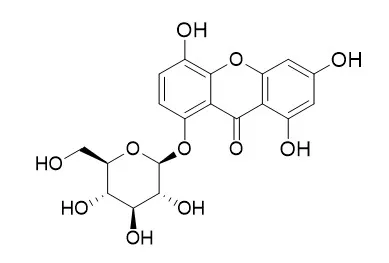| In vitro: |
| Front Pharmacol . 2021 Jul 14;12:677212. | | Norswertianolin Promotes Cystathionine γ-Lyase Activity and Attenuates Renal Ischemia/Reperfusion Injury and Hypertension[Pubmed: 34335249] | | Cystathionine gamma-lyase (CSE)/hydrogen sulfide (H2S) plays a protective role in cardiovascular diseases including hypertension and ischemia/reperfusion (I/R) injury. This study was aimed to screen natural small molecule compounds that activate CSE activity and then evaluate its effect(s) on kidney I/R injury and hypertension. Applying computer molecular docking technology, we screened the natural small molecule compound Norswertianolin (NW)-specific binding to CSE. Using the microscale thermophoresis technology, we confirmed that the Leu68 site was the essential hydrogen bond site of NW binding to CSE. NW supplementation significantly increased CSE expression and its activity for H2S generation both in vivo and in vitro. In the model of acute and long-term kidney I/R injury, NW pretreatment dramatically attenuated kidney damage, associated with decreasing blood urea nitrogen (BUN), serum creatinine (Cr) level, reactive oxygen species (ROS) production, and cleaved caspase 3 expression. In spontaneously hypertensive rats (SHRs), NW treatment also lowered blood pressure, the media/lumen ratio of the femoral artery, and the mRNA level of inflammatory cytokines. In conclusion, NW acts as a novel small molecular chemical compound CSE agonist, directly binding to CSE, heightening CSE generation-H2S activity, and then alleviating kidney I/R injury and hypertension. NW has a potential therapeutic merit for cardiovascular diseases. | | Biomed Res Int . 2019 Jan 20;2019:2692970. | | Effects of Four Compounds from Gentianella acuta (Michx.) Hulten on Hydrogen Peroxide-Induced Injury in H9c2 Cells[Pubmed: 30800665] | | In previous studies, Gentianella acuta (Michx.) Hulten was reported to contain xanthones, iridoids, terpenoids, and sterols and is mainly used to cure hepatitis, jaundice, fever, headache, and angina pectoris. In this study, we used bioassay guided fractionation to identify compounds from G. acuta and investigated their activity against hydrogen peroxide (H2O2)-induced apoptosis of H9c2 cells using the 3-(4,5-dimethylthiazol-2-yl)-2,5-diphenyltetrazolium bromide (MTT) method. The levels of nuclear factor erythroid 2-related factor 2 (Nrf2), heme oxygenase-1 (HO-1), and glutamate-cysteine ligase catalytic (GCLC) expression were assessed using quantitative real-time polymerase chain reaction (qRT-PCR). Protein expression was evaluated using western blot. The results showed that all four compounds had protective effects on H9c2 cells. The transcription levels of HO-1 and GCLC significantly increased in H9c2 cells pretreated with Norswertianolin (1), swetrianolin (2), demethylbellidifolin (3), and bellidifolin (4). However, compared to the model group, the transcription levels of Nrf2 were not enhanced by pretreatment with compounds 1, 2, and 4. The protein expression levels of HO-1 and GCLC in H9c2 cells were greater than that in the H2O2-treated group, and the expression of Nrf2 was not significantly changed except by swetrianolin treatment; inhibitors can reverse the protective effect by ZnPP (15 μM), BSO (10 μM), and brusatol (10 μM). The results indicated that the four compounds isolated from G. acuta inhibited the oxidative injury induced by H2O2 by activating the Nrf2/ARE pathway in H9c2 cells and provide evidence that G. acuta may be a potential therapeutic agent for the treatment of cardiovascular diseases. | | Nat Prod Commun . 2017 Jan;12(1):55-56. | | Chemical Composition, Antioxidant and Anticholinesterase Activities of Gentianella azurea from Russian Federation[Pubmed: 30549824] | | Phytochemical study of Gentianella azurea (Bunge) Holub (Gentianaceae) collected in Buryatia Republic (Russian Federation) resulted in the isolation of twenty-one compounds including bellidifolin, bellidin, isobellidifolin, Norswertianolin, isobellidifolin-8-O-β-D-glucopyranoside, orientin, cynaroside, .cosmosiin, apigenin, 4'-O-caffeoylswertiamarin, swertiamarin-6'-O-β-D-glucopyranoside and sweroside, firstly detected in this species. The extracts and individual compounds were shown to possess antioxidant and anticholinesterase potential. |
|






 Cell. 2018 Jan 11;172(1-2):249-261.e12. doi: 10.1016/j.cell.2017.12.019.IF=36.216(2019)
Cell. 2018 Jan 11;172(1-2):249-261.e12. doi: 10.1016/j.cell.2017.12.019.IF=36.216(2019) Cell Metab. 2020 Mar 3;31(3):534-548.e5. doi: 10.1016/j.cmet.2020.01.002.IF=22.415(2019)
Cell Metab. 2020 Mar 3;31(3):534-548.e5. doi: 10.1016/j.cmet.2020.01.002.IF=22.415(2019) Mol Cell. 2017 Nov 16;68(4):673-685.e6. doi: 10.1016/j.molcel.2017.10.022.IF=14.548(2019)
Mol Cell. 2017 Nov 16;68(4):673-685.e6. doi: 10.1016/j.molcel.2017.10.022.IF=14.548(2019)